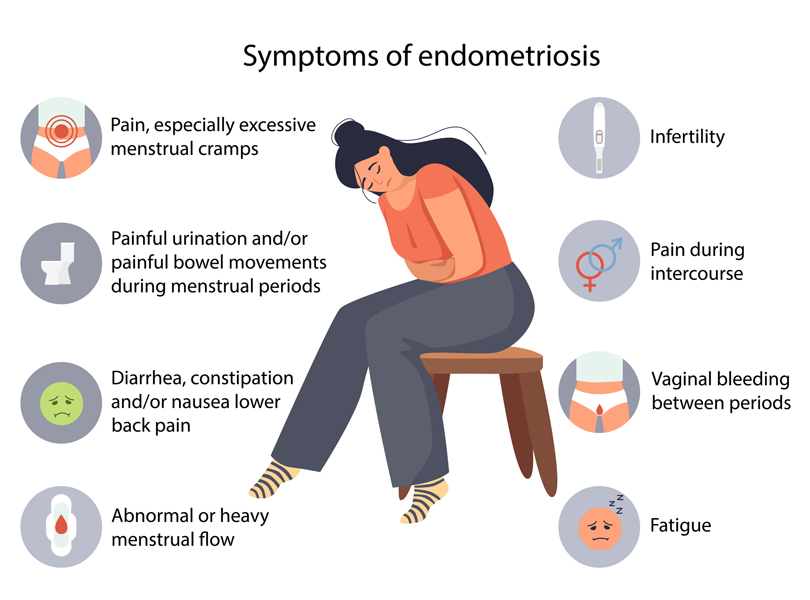By Angela Serednicki
Periods are a normal part of life, but they shouldn’t be causing you pain. Endometriosis is a chronic disease that affects up to 10 percent of people who are assigned female at birth. Painful period cramps are a hallmark sign of endometriosis, which is characterized by the presence of endometrial-like tissue growing outside the uterus. According to the Endometriosis Treatment Center of America, the pain and discomfort associated with endometriosis are not necessarily linked to the stage or severity of the disease, making it challenging to diagnose and manage.
Can birth control pills help endometriosis?
Hormonal therapies can help control the symptoms of endometriosis, offering a chance at a higher quality of life. While some medications can reduce symptoms, there’s no evidence that hormonal therapy stops the growth of endometriosis.
What are the warning signs of endometriosis?
Recognizing the first signs of endometriosis is crucial. Period pain is common, but it isn’t normal. If you find yourself frequently cancelling plans due to heavy bleeding or pelvic pain, it might be time to talk to your doctor about endometriosis. Other symptoms include pelvic discomfort or pain during sexual activity, urination, or bowel movements. Fatigue, bleeding between periods, difficulty getting pregnant, bloating, nausea, and gastrointestinal distress are also common signs to be aware of, as reported by The Endometriosis Foundation of America.

Is endometriosis a reproductive disease?
Endometriosis isn’t confined to the reproductive organs. According to The Endometriosis Network of Canada, endometrial growths can be found on various pelvic organs and surfaces, including ligaments, bladder, ovaries, tubes, uterus, ureters, bowel, and other peritoneal surfaces. In fact, endometriosis has been found in every organ of the body. Endometrial adhesions, which occur when the endometrial tissue deteriorates, often also lead to irritation and inflammation in the nearby region. This process can result in the formation of scar tissue and subsequent complications. For this reason, early treatment is essential as it can help prevent endometriosis from spreading and damaging surrounding tissues or nerves.
What’s the difference between endometriosis and adenomyosis?
It’s important to differentiate between endometriosis and adenomyosis, as they can coexist. As explained by Johns Hopkins Medicine, “Adenomyosis is a gynecologic condition that causes endometrial tissue in the lining of the uterus to grow into the muscular wall of the uterus.” Although adenomyosis can be treated with a hysterectomy, there is currently no known cure for endometriosis.
How do you get diagnosed with endometriosis?
Diagnosing endometriosis requires specialized medical evaluation. The gold standard for diagnosis is laparoscopic surgery, where a surgeon examines the abdominal cavity and surrounding areas to remove endometrial growths. Trained specialists may also diagnose endometriosis through a vaginal ultrasound or MRI, making early detection and treatment possible.
Bindi Irwin, the 24-year-old daughter of the late Steve Irwin, spoke to PEOPLE earlier this year about how challenging it was for her to get diagnosed with endometriosis.
“I know with endometriosis, the sad thing is that it often doesn’t show up on any scans. I got every scan under the sun, and nothing showed up. It wasn’t until I had that exploratory surgery that they knew what was going on,” she says. Irwin explains she only started seeking treatment for endometriosis after finding out that she had similar symptoms to her friend, who also received surgery for the same condition.
Like Irwin, writer, actor, and director Lena Dunham has also publicly shared her experience with endometriosis. Dunham wrote an essay in the March 2018 issue of Vogue detailing her choice to undergo a hysterectomy at age 31 for endometriosis and what appears to be symptoms of adenomyosis.
“In addition to endometrial disease, an odd hump-like protrusion and a septum running down the middle, I have retrograde bleeding, a.k.a. my period running in reverse so that my stomach is full of blood. My ovary has settled in on the muscles around the sacral nerves in my back that allow us to walk. Let’s please not even talk about my uterine lining. The only beautiful detail is that the organ—which is meant to be shaped like a light bulb—was shaped like a heart.”
Although individuals might experience endometriosis symptoms like Dunham and Irwin, some may experience silent endometriosis. “Approximately 30 percent of women with unexplained infertility will have silent endometriosis,” Dr. Lora Liu, an endometriosis specialist with the Seckin Endometriosis Center in New York City, tells Every Day Health.
Endometriosis Surgery Techniques: Excision vs. Ablation Surgery
Excision surgery is considered the gold standard treatment of endometriosis. This technique involves the removal of endometriosis at its root, providing a more effective and lasting solution than ablation surgery, which only burns the surface of endometriosis. Finding a skilled endometriosis specialist is crucial to achieving the best outcome.
The Future of Endometriosis Care in Canada
In a positive development, the Government of Canada has recently allocated more than $1.6 million in funding to The Endometriosis Network Canada and The Society of Obstetricians and Gynaecologists of Canada. This funding will support educational initiatives, including a nationwide public awareness campaign, and assist patient groups facing additional obstacles in accessing proper care, such as Indigenous communities, marginalized racial groups, and individuals identifying as 2SLGBTQI+. This step towards better care and awareness brings hope for a brighter future for those affected by endometriosis.












